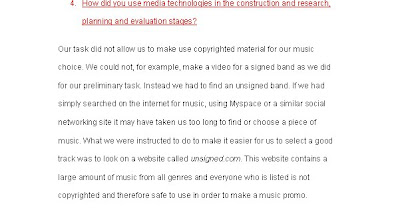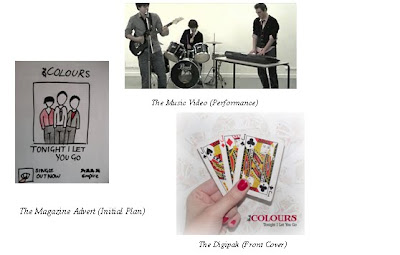The Digipak

A Digipak is the design for the CD case on an album or single. Its roots lie with music being put on records in the past; those records were placed in sleeves that bore the name of the music and the artist who had created it. The same principle lies with the CD Digipak. It serves the purpose of advertising the band and their brand image to their potential audience. When looking for music in a shop, the first thing you will see is the Digipak front cover, it has to draw you to the product in the first place before anything else. Digipak’s do this by showcasing an interesting image on the front cover. Bands have been known to use controversial or unusual images to catch the public’s attention.
Kanye West’s album art for ‘My Beautiful Dark Twisted Fantasy’ uses a sexually explicit image for its album art work in order to create controversy. Consequently, some music stores refused to stock the album until alternate artwork was provided. iTunes uses a pixelated version of the image.

Our Digipak does not use controversial imagery to grab the audience. Instead it serves the purpose of representing the bands image and style that a potential audience will have come to recognise. Our Digipak uses the white colour scheme with bright colours in the foreground. This corresponds with the colours in our music video.
Magazine Advert

A magazine advert has a number of uses. The main one being a way of advertising a piece of music in paper form for people who are interested in that particular genre of music. Of course, there is no way of physically showing the music to the audience so the magazine advert serves the purpose of providing an interesting image that should grab the attention of the people looking at the magazine sufficiently enough to prompt them into listening to the music online which will further encourage them to buy it.
Similar to the Digipak, a magazine advert also serves the purpose of creating a brand image for the band. The pictures used should bear some relation to the band and when an audience view it, they should instantly be able to make connections to other images that that band may have produced. This is what we attempted to do with our magazine advert. We used a theme that we had taken from an original idea used in the music video and placed it in both the Digipak and the magazine advert. The idea we chose to expand upon to create a band identity was the cards. During pre-production phase when we were deciding how our music video was going to be structured, we decided on using a shower of cards to signify the end of our video. This idea was then taken and incorporated into the ancillary tasks.
In terms of the different pieces of work promoting each other, I think that if someone was to see the magazine advert and then the Digipak, or vice-versa, they would be able to make the connection that the two were products of the same band, I would however say though, that the music video does not have a strong enough link with the card theme because the only use of cards were at two points when the main band member used cards because it was relevant with the mise-en-scene and at the end of the video. The reason we used less of the card theme in the music video was because we did not know what to what extent we would use the card idea. Looking back, we would have been better to simultaneously plan the ancillary tasks and the music video in order to maintain the strongest synergy between the three products.
When researching other bands, I discovered that bands generally try and portray a very strong image through their music videos; they often do this through the clothes they wear. Therefore I delegated costume designing to Lizi and she had to determine what clothes would appeal to an Indy/rock band. She came to the conclusion that the correct clothes to wear would be the skinny tie and cardigan combination, similar to the theme of Mumford and Sons.
Traditional media vs. new media is a topic debated by those knowledgeable in such areas. Traditional media consist of the older types of advertisement of media, which includes music television programs and magazines. These were founded before the internet and as such, provided music in that time period a way to get to there audience. These days, the popularity of the internet has prompted music distributors to showcase there work on the internet. The advantages of more traditional forms of media are that people without access to the internet are still able to access the music that they are looking for. This is, however, becoming increasingly less necessary because more and more people have, not just access to the internet, but access to a high speed internet connection. This is a crucial advantage to new media because now we are now capable of downloading music in a matter of seconds whereas before, if we wanted the latest release, we had to go into a music store and physically buy the cd.
 From the questionnaire we discovered that most people thought that a successful music video should have the narrative and the performance split of about 30:70. We did however go on to create a video with a much larger narrative focus than this. We did this because we wanted to break typical conventions of music videos, but also because we thought we would be more adapt at creating a more narrative focused video due to my skills at creating narratives as I had proved in the creation of the AS project.
From the questionnaire we discovered that most people thought that a successful music video should have the narrative and the performance split of about 30:70. We did however go on to create a video with a much larger narrative focus than this. We did this because we wanted to break typical conventions of music videos, but also because we thought we would be more adapt at creating a more narrative focused video due to my skills at creating narratives as I had proved in the creation of the AS project. One of the ways we did this was through the website ‘Youtube’. The video was uploaded to the website and then we asked for comments. In addition to just thee comments, Youtube also provided us with stats and figures we could use to gauge the age and home country of the viewers. We could see that our video was indeed popular with the people who were the intended audience. Youtube providing these statistics was helpful because a questionnaire is not the best way to get a response due to the large amount of people who do not reply to it, using Youtube we were able to gain information without people having to input it in themselves, using up their own time.
One of the ways we did this was through the website ‘Youtube’. The video was uploaded to the website and then we asked for comments. In addition to just thee comments, Youtube also provided us with stats and figures we could use to gauge the age and home country of the viewers. We could see that our video was indeed popular with the people who were the intended audience. Youtube providing these statistics was helpful because a questionnaire is not the best way to get a response due to the large amount of people who do not reply to it, using Youtube we were able to gain information without people having to input it in themselves, using up their own time. 

 Our Digipak does not use controversial imagery to grab the audience. Instead it serves the purpose of representing the bands image and style that a potential audience will have come to recognise. Our Digipak uses the white colour scheme with bright colours in the foreground. This corresponds with the colours in our music video.
Our Digipak does not use controversial imagery to grab the audience. Instead it serves the purpose of representing the bands image and style that a potential audience will have come to recognise. Our Digipak uses the white colour scheme with bright colours in the foreground. This corresponds with the colours in our music video.

























